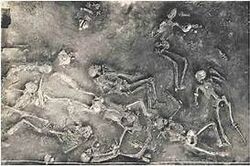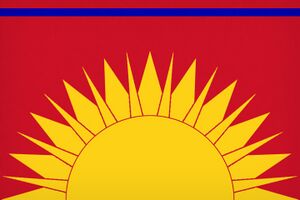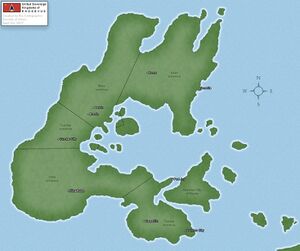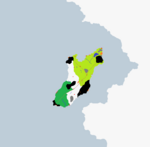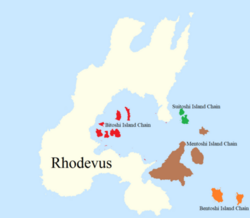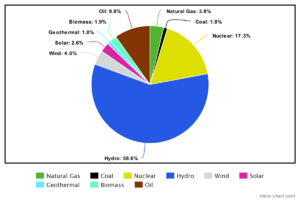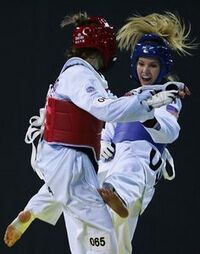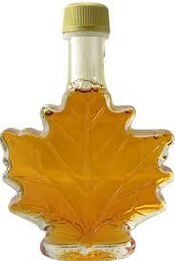Rhodevus
This article is incomplete because it is pending further input from participants, or it is a work-in-progress by one author. Please comment on this article's talk page to share your input, comments and questions. Note: To contribute to this article, you may need to seek help from the author(s) of this page. |
The United Sovereign Kingdoms of Rhodevus
Les Royaumes Souverains Unis de Rhodevus (French) | |
|---|---|
|
Flag | |
| Motto: Ad Victoriam (Latin: Until Victory) | |
| Anthem: United we Stand | |
| Capital | Kingstown |
| Official languages | English, French, Native Rhodeavn |
| Recognised regional languages | Native Rhodevan Dialects |
| Ethnic groups (2017) | 89.4% Caucasian 10.6% Others |
| Demonym(s) | Rhodeve |
| Government | Rubinian Monarchy |
• Queen | Diana Wolff |
• Princess Heir | Sierra Everen-Abrams |
• Imperial Premier | Edwin Buoecen |
| Legislature | The Parliament of Rhodevus |
| Senate | |
| House of Commons | |
| Established Republic of Rhodevus | |
• Treaty of Statehood | 5 May, 1715 |
• Treaty of Bussón - Rubinian Monarchy | 5 May, 1845 |
| Area | |
• Total | [convert: invalid number] |
• Water (%) | too much |
| Population | |
• 2018 estimate | 85,273,096 |
• Density | [convert: invalid number] |
| GDP (PPP) | 2018 estimate |
• Total | High |
• Per capita | Enough |
| HDI (2015) | 0.937 very high (6th) |
| Currency | Rhode (R) |
| Time zone | UTC+0 (No clue) |
• Summer (DST) | UTC+1 (Observed) |
| Date format | dd-mm-yyyy |
| Driving side | the right |
| Calling code | +398 |
| ISO 3166 code | RDV |
| Internet TLD | .rdv |
The Kingdom of Rhodevus, commonly referred to as Rhodevus (pronounced /roʊdivəs/), is a Non-Hereditary Absolute Representative Monarchy located in Northern Dogmana. It is a large-sized country with a population of around 85.2 million people, most of which live in the country's six provinces and two territories in Dogmana. Around 5.5 million Rhodeve live on the Ile du Fleurs off the coast of Ventismar, giving Rhodevus a maritime border with Makenzie and Athabaska. Around 2.5 million people live on the The Iles du Surèté in the Divergian Ocean. Rhodevus proper borders Aznazia to the South.
The country's capital is Kingstown and it's largest city is Quiniac City, with the second largest city being Port joy, which hosts the country's largest sea port. The third largest city is Carpellin.
Rhodevus is one of the founding members of the United Sunalayan Assembly. It is also a founding member of the International Anti-Terror Association, Imperial Formations Treaty and the Rhodeve Commonwealth. Its currency is the Rhode.
Rhodevus has a free market economy, and ranks in the top ten GDP per capita in the world. It is one of the 10 largest economies in Sunalaya, and is ranked 7th in the human development index with a very high standard of living.
Etymology
While a variety of theories have been postulated for the etymological origins of Rhodevus, the name is now accepted as coming from the Port Joy Laaban Tutzo word Rudo Evulo, meaning "bountiful of sea creatures". In 1326, indigenous inhabitants of present day Port Joy region used the word to direct French explorer, Beaumant LaFriore to the Straights of Rhode, where the severely malnourished explorer and crew would be able to catch fish to eat. Beaumant LaFriore used an amalgamation of those words to describe the entire region in Laaban Tutzo control. By 1425, Ventismarien books and maps had begun referring to this small region along the Straights of Rhode as Rhodevus.
From the 16th to the early 17th century, "Rhodevus" referred to the part of New Capsland that lay along the Straights of Rhode, as well as the official name for the French North of the island. Following the Failed Revolution and the signing of the Treaty of Rhodevus, the entire landmass and its islands became collectively known as Rhodevus.
The demonym of the people also holds a unique variety and variation not found globally. The standard way to refer to a person from Rhodevus is a 'Rhodeve'. This term includes all people groups which inhabit the country and the term used to describe objects made in Rhodevus. 'Rhodeven' is an older variant and one not as commonly used in modern times. Historically, it meant a Rhodeve of Ventismarian descent. This was paired with 'Rhodevan', used to denote a Rhodeve person of native descent. The term Rhodevan has since fallen into disuse as it has picked up a negative connotation. Instead to refer to native peoples, the term 'Native Rhodevan' is used. As Rhodevan fell into disuse, so too did it's Ventismarien counterpart, due to how similarly the two words sound to those unfamiliar with native language.
Demographics
Language
Rhodevus's national languages are English, French and Native Rhodevan. Schools nationwide teach the language and use it for instructions. English is predominantly spoken in the urbanized South of the country, while French is mainly spoken in the North. Native Rhodevan and its many dialects are spoken throughout the country, especially in rural communities. Informal communication in many rural areas is usually conducted in what is collectively referred to as Gulong , which is a mixture of English, French and Laaban Dialect of Native Rhodevan.
Around 93% of the Lindian population is at least fluent in the English or French languages. With the remaining 7% consisting mostly out of foreigners.
Around 67% of Rhodeve have English as their first language with 28% having French as their first language. The remaining 5% are a mixture of native and international languages.
In a survey by StatsRhodevus in 2016, around 81% of Rhodeve above the age of 18 were conversationally proficient in English and around 55% were sufficient in French. 71% considered themselves bilingual and 39% considered themselves trilingual.
Religion
Religion in Canada encompasses a wide range of groups and beliefs.
Christianity is the largest religion in Canada, with Roman Catholics having the most adherents. Christians, representing 66.7% of the population in 2016, are followed by people having no religion with 12.8% of the total population. Other faiths include those with Rhodeve Ancestry (6.5%), Jews (4.1%), Muslims (3.3%), Buddhists (3.0%), and Sikhs (1.0%). Rates of religious adherence are steadily decreasing. The preamble to the Rhodeve Charter of Rights and Freedoms refers to God. However, Rhodevus has no official religion, and support for religious pluralism and freedom of religion is an important part of Rhodevus's political culture.
Health
Lindenholt boasts a healthcare system renown for its standards and quality. But Rhodevus's is better.
Education
History
See Also: History of the Ile du Fleurs
See Also: History of The Iles du Surèté
Ancient Rhodevus
Indigenous Peoples
First known records of human habitation on the main island of present day Rhodevus is documented to be around circa. 12,000 BCE. It is thought that humans crossed over land bridges from the Corentian continent formed during that time, taking up residence in Southern Rhodevus. Fossil records have found skulls and bones of early Rhodeve settlers as well as rudimentary stone tools surrounding areas that could have been campsites.
From this time until 5,000 BCE, little is known of ancient Rhodeve history aside from the spread of the inhabitants across the entire island. Circa. 5,000 BCE is when the first documentation of Rhodevan mythologies have been found. This comes in the form of stone and clay idols as well as Tree-Shapes in the West and South. The first true villages have been set up in present day Quiniac City and Redford in Tundos as well as Sigfree and Willowall in Iylan among other places.
A thousand years later, carvings found in Northern Iylan show depictions of the Gometz Highlander Myth. This myth forms the basis of the Ghong Tribe’s founding. It can be predicted that the Ghongg Tribe was founded around this time making it the oldest Rhodevan Native tribe by about 1,500 years. Also found in the area were dozens of bones of deformed children and elderly, revealing that this ancient precursor to the Modern Ghong sacrificed the elderly and deformed. Most likely to appease an ancestral spirit or diety. In 3,000 BCE, archeological evidence finds tools and weapons made in the Lirban format. The Lirban people were a native group from Philomachus. Landing in the Bentoshi Island Chain circa 3,100 BCE, the people began attacking their way through the Southern half of the country before most likely taking up permanent residence in the Mentoshi island Chain, in what is now the Imperial City of Rhode. Along with bringing new types of weapons to the island, the Lirbans also brought with them a new style of mythology, which focused less on weather and more on plants, animals and spirits. It is also widely believed that the Lirban tribe and the spread of their language lead to the ancient Rhodevan languages as well as became a precursor to the Laaban Tribe, which was also found in the Mentoshi Island Chain. Lirban practiced relied heavily on sacrificial human slaughter, as can be noted in burial pits found across the ICR as well as sacrificial alters in Eastern Tundos.
500 years after, what can be more commonly linked to as Rhodevan religion or mythos can be seen all around the island and its island chains. The first recorded evidence of the symbol used to describe Ke-etunbits Taharei can be seen carved into multiple caves and mountainsides. The largest of these carvings are on Mount Benner at an elevation of 4,284 meters, in the Richard Weilland Caves and the San Blanc Caves in Wyle, Tundos and Iylan respectively.
Circa. 2,300 BCE was when the first true carvings can be dated back to for the Laaban Retwa Tribe, a proto-tribe considered to be the precursor to the Laaban tribe. The Laaban Retwa held similar beliefs and practices to the pre-modern Laaban tribe, such as a myth and story structure in song form, body-painting of images to give the wearer strength or special powers as well as fire-death circles; a now out of practice dance wherein the dancers would dance around a fire to call on death to strike a certain person or group. These practices, recorded through carvings mainly on bone and stone, show the precursors to what would eventually become more standardized beliefs and customs, seen around 1000 CE.
Early Rhodevus
Joint Colony Period
The Rhodevan-Colonial Wars
The Failed Revolution (1671-1673)
From the 1630s onward, national fervor had grown due to the successful end to the Rhodevan-Colonial Wars. As a majorly colonist led war, especially in the final decades, it helped to unify the multiple colonies on the island into a strong mostly unified people who began to identify less with their colonial homelands and more with the land they fought to claim. It was in the 1640s that Rhodevus began to emerge as the name for the system of colonies as a whole, as opposed to just the islands where these colonies were located.
In 1641, the Capslandian colonies in the south and French colonies in the north signed the 'Treaty of Religious and National Respect', which would ease tensions between Catholics and Protestants on the island, as well as declare that the two main colonies on the islands would work together to achieve their goals for fair economic and industrial practices. This would become the first treaty signed between colonial governors without the input, or permission granted to them by their governments in Ventismar.
By 1650, the Treaty of Religious and National Respect was further signed by the Englean colony of Ludendorff and the Ruzkov speaking colonial towns of Wroclaw, Lublin and Katowice.
Nationalistic fervor continued to grow, with the development of the Rhodevus Daily (1652) and Kingstown Daily (1657) newspapers which spread news and information around the nation.
In 1652, the Acadian Fire burned down large portions of the city. it had been started by independence supporters in an attempt to remove the governor and his family from the city. In a twisted turn of events, the Governor's Mansion remained one of the few buildings untouched by the fire after the wind turned, spreading the flames to the poorer districts of the city. The men responsible were arrested and flogged, then hanged four days later. This event was spread across the islands' colonies through newspapers as a sign of nationalistic reprisal. Articles would detail the cruel execution of these men, but many papers would leave out the reason behind their executions. This would lead to further revolts and riots in cities such as Quniac City, Cundas City, Kingstown and Rome throughout the ensuing decade.
In 1659, a seamstress by the name of Mari DuSond sewed a primarily red flag called 'The Rising Sun'. It would gain popularity and become the official flag of Rhodevus's independence movements by 1666.[1][2]
1665 saw the establishment of the Rhodeven Senators Guild, which would house diplomats from all colonies on the central island.[3] They would be tasked with dividing up the largest colonies into states as well as drafting the First Constitution of Rhodevus. The constitution was completed in 1670 and a proclamation of independence was presented in 1671.
Fighting between backers of the colonial empires in Ventismar and the newly established Rhodevens began almost immediately following the declaration of independence. The first shot of the war were said to have been fired by Susanna D. Corroly against a loyalist who had attempted to burn down her father's farm just outside of Cundas City.
The first Capslandian ships to arrive were those under the command of the Royal Capslandian Shipping Company. Their arrival would result in the First Battle of Port Diamond, in which the RCSC fleet of five ships faced off against the combined Rhodeve controlled fleet of five ships. This minuscule Rhodeve fleet was the entirety of Rhodeve controlled war ships at this time. It resulted in a Rhodeve victory, with the capture of one ship and sinking of one more, without any Rhodeve ship losses.
At the same time, fighting had erupted between loyalist and Rhodeve forces in Quiniac City, Fallow Hills and St. Goldith. St. Goldith was of particular note, as the town held a valuable metallurgy industry which could be used to fit sailing ships with cannon. St. Goldith fell to Rhodeve forces within three weeks of the declaration of independence.
In May of 1671, the Rhodeve fleet led by Captain Julian Fyres blockaded Port Joy, keeping the few remaining Capslandian ships harboured at the docks. The Port Joy militia, under the command of Alfred Taylor fought against a small loyalist-Capslandian force defending the city. The city would fall to the Rhodeve rebels and become the capital of the Democratic States of Rhodevus.
By September 1671, the Democratic States of Rhodevus would control Port Joy and much of the surrounding lands, up to the Setan coast in the West, Cundas City in the North and Quiniac City as the south, with Kingstown and Quiniac City remaining steadfast loyalist holdings. A continued siege of Kingstown would remain in effect until its fall in the winter of 1672.
In December of 1671, a Capslandian fleet of twelve ships, carrying reinforcements would arrive in Acadia, linking up with the French forces in the North. A blockade would be established, using the colony of Bavven Rhode as a base of operations. The colony would remain loyal to the Capslandian empire, even with overtures of peace and union with the Democratic States.[4]
The Battle of Wilkins' Wood, in 7 January 1672 outside of Brevin would be the first major Rhodeve defeat, seeing the capture of 700 soldiers.
The First Republic of Rhodevus
The Rhodeve Empire
The Second Republic of Rhodevus
The Kingdom of Rhodevus
The World Wars
The Cold War
The King James Wars (2006-2007)
The Modern Era
Geography
Rhodevus spans a vast, diverse territory, surrounded by the Lutentian Ocean to the East and the Ocean to the West. There are over 2 million lakes in Rhodevus; many of which are inaccessible, as well as countless rivers, streams and water basins. It is possible to navigate through the entire country just by using the country's waterways. The country possesses three major mountain chains, as well as multiple other mountains. Most single mountains are extinct volcanoes, the youngest of which last erupted 9.3 million years ago.
Along with the main island of Rhodevus, there are dozens of smaller islands around its coast, divided into four island chains based on geographical location.
Climate
| Climate data for Kingstown (1998–2018 averages) | |||||||||||||
|---|---|---|---|---|---|---|---|---|---|---|---|---|---|
| Month | Jan | Feb | Mar | Apr | May | Jun | Jul | Aug | Sep | Oct | Nov | Dec | Year |
| Record high °C (°F) | 19.4 (66.9) |
22.6 (72.7) |
28.5 (83.3) |
37.2 (99.0) |
42.2 (108.0) |
43.3 (109.9) |
45.0 (113.0) |
43.3 (109.9) |
40.0 (104.0) |
34.0 (93.2) |
26.1 (79.0) |
22.2 (72.0) |
45.0 (113.0) |
| Average high °C (°F) | 5.6 (42.1) |
6.4 (43.5) |
10.0 (50.0) |
14.0 (57.2) |
18.0 (64.4) |
20.4 (68.7) |
22.8 (73.0) |
22.6 (72.7) |
19.1 (66.4) |
14.6 (58.3) |
9.6 (49.3) |
6.1 (43.0) |
14.1 (57.4) |
| Daily mean °C (°F) | 3.1 (37.6) |
3.3 (37.9) |
6.2 (43.2) |
9.2 (48.6) |
13.1 (55.6) |
15.6 (60.1) |
17.9 (64.2) |
17.5 (63.5) |
14.5 (58.1) |
10.7 (51.3) |
6.7 (44.1) |
3.7 (38.7) |
10.1 (50.2) |
| Average low °C (°F) | 0.3 (32.5) |
0.2 (32.4) |
2.3 (36.1) |
4.1 (39.4) |
7.8 (46.0) |
10.5 (50.9) |
12.8 (55.0) |
12.3 (54.1) |
9.9 (49.8) |
6.9 (44.4) |
3.6 (38.5) |
1.0 (33.8) |
6.0 (42.8) |
| Record low °C (°F) | −61.1 (−78.0) |
−63.0 (−81.4) |
−54.7 (−66.5) |
−48.9 (−56.0) |
−32.2 (−26.0) |
−20.6 (−5.1) |
−8.9 (16.0) |
−15 (5) |
−31.7 (−25.1) |
−41.7 (−43.1) |
−54.4 (−65.9) |
−60.0 (−76.0) |
−63.0 (−81.4) |
| Average precipitation mm (inches) | 50.8 (2.00) |
49.7 (1.96) |
56.6 (2.23) |
64.8 (2.55) |
76.8 (3.02) |
84.3 (3.32) |
86.5 (3.41) |
87.8 (3.46) |
83.6 (3.29) |
74.7 (2.94) |
81.0 (3.19) |
72.9 (2.87) |
869.5 (34.23) |
| Average precipitation days (≥ 0.1 mm) | 13 | 13 | 12 | 11 | 11 | 11 | 11 | 10 | 11 | 11 | 13 | 14 | 141 |
| Average snowy days (≥ 0 cm) | 14.1 | 9.7 | 7.4 | 2.7 | 0.1 | — | — | — | — | 0.8 | 5.1 | 12.2 | 52 |
| Average relative humidity (%) | 87 | 84 | 81 | 75 | 75 | 76 | 77 | 79 | 84 | 86 | 89 | 89 | 82 |
| Mean monthly sunshine hours | 62.3 | 85.7 | 121.6 | 173.6 | 207.2 | 193.9 | 206.0 | 187.7 | 138.3 | 112.9 | 63.0 | 49.3 | 999.9 |
| Source: statsrhode.rdv/en/weather/Kingstown | |||||||||||||
Administrative divisions
Provinces
Rhodevus is comprised of six provinces.
Territories
Rhodevus holds two territories. The Ile du Fleurs, located in Ventismar and the Iles du Surèté, located in the Divergian Ocean.
The Ile du Fleurs
The Ile du Fleurs (IdF) has a unique landscape that is commonly divided into three regions. The Southern Forests, the Northern Grasslands (sometimes referred to as the Northern Plains) and the Central Shield (known as the Fleurian Shield).
The south of the island is filled with a large connected forest which takes up one third of the island. It receives the most rainfall at an average 650mm per year, which get filtered through its soil into the dozens of rivers which cross the landscape.
The center of the island is the Fleurian Shield, which is the lowest part of the IdF. It holds the island's largest two lakes; Lake Hullien and Lake Jeremy, which connect via the Hullien River. It holds the island's largest mountain, Mount Hellen, which stands 867 meters.
The north portion of the island is the Northern Plains. Trees; while present, are much more rare than the south. Instead, this third of the island is covered in a large grassland slope. There are three mountains, Mount Victoria, Mount Argus and Mount Francis; standing 603, 427 and 300 meters respectively. It also contains the third major lake on the island, Lake Rose. This third receives the least rain at 300mm per year on average, less than half of its southern portion.
The Iles du Surèté
The Iles de Sûreté are an island chain made up of 47 islands, with the islands of Myann and Nooderhaaks being the only two which are inhabited.
Myann is the largest island and is recognized for it's incredibly odd shape, with dozens of islets off the coast.
The capital of the island chain is Artwingen, located on the island of Nooderhaaks.
Island Chains
The Bitoshi Island Chain
The Bitoshi Island Chain is a group of hundreds of islands, all found within the Bay of Rhodevus and Bay of Benner. There are 6 major islands, with hundreds of small and tiny ones. Bitoshi translates to Inner or Central Fire Rock. Four of the major islands are inhabited, and all share the same geography.
They are predominantly hilly and covered in grass with a sparing variety and amount of trees. From largest to smallest, the islands are named Bulta, Bisho Mai, Dullio Shi Mai, Miquishikki, Yukon and Similkameen. Across all six islands, there are 42,000 inhabitants.
The Suitoshi Island Chain
The Suitoshi Island Chain is a group of two islands in the north east of the country. Suitoshi translates to Outer Fire Rock. Both islands are uninhabited. From north to south, the islands are named Sinaliarpok and Kissermiorpok which translate to 'goes to the edge of ice' and 'solitary or alone' respectively. The former due to the amount of ice cover and the latter due to the single tree on the island
Sinaliarpok is completely covered in ice. Without the ice, the island would be a tenth the size. Kissermiopok is also primarily covered in ice. While Sinaliarpok is mostly flat, Kissermiopok is hilly, with the topmost peak standing 104 meters above sea level. At the top is a single arctic willow nicknamed Napaaqtuq or 'nappy' for short. In 2001, after tourists were caught trying to take branches from the tree, it was made a federal offense to damage Napaaqtuq and the entire island has since become a nature reserve.
The Mentoshi Island Chain
The Mentoshi Island Chain is comprised of three islands, including the Imperial City of Rhode. The other two islands are named (in order from south to north): Batten Rhode and Lavvan Rhode. Mentoshi, translating to Big Fire Rock is named such after the Imperial City of Rhode, being the largest island. Batten Rhode is the third largest island in Rhodevus, behind the Imperial City of Rhode and the Rhodeve mainland, with Lavvan Rhode being the fifth, just behind Kuckata.
The Bentoshi Island Chain
The Bentoshi Island chain refers to the two large islands to the south east of the country. As their name suggests, the Bentoshi islands; translated to Southern Fire Rock islands, are two islands which developed due to volcanic activity. The islands themselves are named Kuckata and Siggen. Both are uninhabited, with Siggen containing the only active volcano in the country.
Kuckata is a mountainous island, due to it's ancient volcano. The tallest mountain in Mount George, though it is often referred to as Georgian Peak. The island is covered in grasses and oak and cedar trees. There are four major rivers on the island, which run from the icy top of Georgian Peak down to the ocean.
Siggen is a barren island which is continuously growing due to the active volcano. There are no trees and grasses on the island, but lichen due cover a good portion of it.
Largest cities
Largest municipalities in Rhodevus
SourceRhode | |||||||||
|---|---|---|---|---|---|---|---|---|---|
| Rank | Province | Pop. | Rank | Province | Pop. | ||||
| 1 | Imperial City of Rhode | Imperial City of Rhode | 28,424,365 | 11 | Belvin | Wyle | 805,244 | ||
| 2 | Quiniac City | Tundos | 5,583,064 | 12 | Cundas City | Cundas | 731,438 | ||
| 3 | Port Joy | Tundos | 3,824,221 | 13 | Artwingen | The Iles du Surèté | 521,179 | ||
| 4 | Carpellin | Tundos | 2,781,870 | 14 | New Lelystad | The Iles du Surèté | 397,762 | ||
| 5 | Kingstown | Yztal | 1,236,324 | 15 | Rome | Wyle | 215,719 | ||
| 6 | Boundary Bay City | Ile du Fleurs | 1,195,229 | 16 | Lièvremont | Tundos | 193,437 | ||
| 7 | [[Acadia]] | Iylan | 959,869 | 17 | Wybdumpt | Yztal | 180,442 | ||
| 8 | Killon | Ile du Fleurs | 948,005 | 18 | Meintin City | Tundos | 169,973 | ||
| 9 | Whistleton | Ile du Fleurs | 933,769 | 19 | Fallow Hills | Cundas | 148,358 | ||
| 10 | Brevin | Wyle | 821,599 | 20 | Arynia | Yztal | 122,955 | ||
Politics
Parliament
Political parties
Cabinet
Royalty in Rhodevus
Rhodevus is a Rubinian Monarchy lead by Queen Diana Wolff. The current Princess Heir is Sierra Everen-Abrams.
Local politics
Foreign relations
Rhodevus holds a vast network of allies, alliances and trade relations with almost every country in the world. Rhodevus is one of the largest global exporters.
NONE OF THIS IS UPDATED YET! LEAVING IT HERE SO I DON'T NEED TO REMAKE THE CHART
| Country | Formal Relations Began | Notes |
|---|---|---|
| Year | Notes | |
| 1922 | Aznazia is Rhodevus's top trading partner in Dogmana
| |
| year | notes | |
| Year | * The 1977 Rhodevus-Capsland Nuclear Energy Deal | |
| Template:Country data Eubatu | 1876 | * The 1880 Rhodevus-Eubatu Coal Deal. Deal renewed in 1915, 1950 and 1985 |
| year | Notes | |
| Template:Country data Ispanza | 1891 | The 1891 Rhodevus-Ispanza Trade Agreement (RITA) |
| Template:Country data Layfet | 1717 | Rhodevus was the first nation to recognize an independent Layfet in 1717, and the two have been allies ever since, enjoying a close relationship. Layfet remained in the Rhodeve sphere of influence until the Great War. The two share many cultural aspects. The two's most ambitious projects together include the The Layfet-Rhodevus United Education Agreement (s.2017) which aims to give more opportunities to students to study abroad as well as work and live in each other nations. Other agreements between the two include the Layfet-Rhodevus Student Exchange Agreement (s.1989), Layfet-Rhodevus Aid and Science Agreement (s.1999), Layfet-Rhodevus Space Operations Agreement (s.2004), and the Layfet-Rhodevus Free Trade Agreement (s.1966). |
| Year | * Makenzie and Athabaska is a member of the Rhodeve Commonwealth | |
| Year | Notes | |
| Year | * The 1955 Rhodevus-Pantorrum Free Trade Deal
| |
| Year | Notes | |
| Year | Notes | |
| Year | Notes | |
| Year | Rhodevus and Sunrisia currently have a rocky and tenuous relationship | |
| Year | Notes |
Military
Economy
Transport and infrastructure
Energy
Rhodevus is one of the few developed nations that are net exporters of energy. This is due to Rhodevus having access to almost all main sources of energy including oil, coal, hydropower, biomass, solar, geothermal, wind, marine and nuclear. Rhodevus is the second largest producer of uranium and third largest producer of hydropower. Due to geological events in the landmass's formation, there is little to no natural gas in Rhodevus and all natural gas must be imported from abroad; primarily Aznazia.
Rhodevus has a robust energy profile with abundant and diverse resources. The energy and climate policies in Canada are interrelated. These energy and climate policies are implemented at both the federal and provincial government level. The federal government is responsible for establishing objectives for the entire country and the provincial governments are responsible for enforcing these objectives and developing the methods to achieve these goals.
Multiple trans-provincial deals have been established to ensure the electrical needs of those in smaller communities and extremely low density areas are met. The 1982 Wyle Executive Deal between Wyle, Iylan and Cundas provincial governments was established to build facilities to power homes in Northern Wyle, without the need for coal plants.
Rhodevus has aimed to stop using coal for electrical consumption by 2027. There are currently only 3 coal-fired power plants remaining in the country, two in Wyle and one in Cundas. Deals organized between the federal and provincial governments have been made to provide monetary aid in building a new hydroelectric damn in order to not only replace the coal plant, but also reduce the amount of oil is used for electricity generation in the province. Similar deals have been made in Wyle in order to harness the provinces massive geothermal energy reserves.
| Division | Coal | Natural Gas | Hydro | Atomic | Wind | Solar | Biomass | Geothermal | Oil |
|---|---|---|---|---|---|---|---|---|---|
| Template:Country data Imperial City of Rhode | N/A | 6 | 54 | 12 | 9 | 10 | 1 | 1 | 7 |
| Template:Country data Tundos | N/A | 1 | 70 | 20 | 5 | 3 | 1 | N/A | N/A |
| Template:Country data Yztal | N/A | 10 | 20 | 41 | 2 | 2 | 1 | 13 | 11 |
| 1 | 2 | 74 | 13 | 1 | N/A | 1 | 1 | 7 | |
| N/A | 2 | 95 | N/A | N/A | 2 | 1 | N/A | N/A | |
| Template:Country data Wyle | 2 | 3 | 60 | 10 | 1 | 1 | 1 | 3 | 19 |
| N/A | 1 | 15 | N/A | 37 | 45 | N/A | N/A | 2 | |
| Template:Country data Iles du Surete | N/A | N/A | 0.3 | N/A | 34 | 4 | N/A | 0.7 | 61 |
| Template:Country data Ile du Myars | N/A | N/A | 5 | N/A | 48 | N/A | N/A | 5 | 42 |
| 1 | 4 | 58 | 17 | 4 | 3 | 2 | 1 | 10 |
Culture
Holidays
Festivals
Art
Rhodeve music ranges from Classical; written in the early 1800's to Rock which is being written up to this day. Most music is written and performed by hand without using computers and voice software. This gives Rhodevus a much more humanistic feel to the music and less robotic and techno. Rhodeve art is mainly sculptures created by hand and made out of the clay and stones found in the Province of Tundos.
Philosophy and literature
Rhodeve classical literature is mainly poetry about the beginning of Rhodevus and the various wars which where fought within the country. Some famous poetry is The Sun and Moon, May he be Remembered, Lost but not Forgotten and Wither Away.
Architecture
Media and Cinema
Theatre
Sport
Rhodevus has two national sports. Ice Hockey has been the most popular sport of Rhodevus even before its founding as an independent nation and is considered the winter national sport. Laabando, a Rhodeve martial art is considered the summer national sport. Other popular sports include basketball, baseball, rugby and soccer/football. Soccer/football is the sport most played by those between the ages of 5-15, with just over half of the population playing it in some form.
Martial Arts holds a unique place in Rhodeve sporting culture, as there are three unique styles which were created in Rhodevus. They are called Laabando, Sukansi and Wenkata. Sukansi originated in circa 200 BCE, but its original year of creation is completely open to debate. This Rhodeve martial art originated in Northeastern Rhodevus, in the Ghong tribe and was used by local fishermen as a means to defend themselves against pirates, and raiders and terrorized their villages and settlements. Sukansi has since gone from a military use to a purely recreational and spiritual one, often being used as a way to relax and sooth the body. There are two styles of Sukansi; Kuhngya-wei and Sei-Tambo. Kuhngya-wei was developed in 200 BCE. This form of Sukansi uses alternating slow and fast movements. Usually with open hands, this form uses strikes to softer pats of the body, like the neck, hip and groin. This form often will use blocks, jabs, strikes, as well as locks and pressure points Sei-tambo was developed in 500 CE, and is the more recreational form of Sukansi, only using slow movements. Again, it uses open hands, but in this form, the strikes and jabs are not used. Instead, blocks and locks are used in sequences with very slow, fluid like movements to grab opponents and bring them to the ground.
Laabando originated much later in 1000 CE, by the Laaban tribe in the far South of Rhodevus. Although there had been speculation that Laabando was a different style of Sukansi, it was later disproven when written artifacts were discovered about the original creator of the martial art; a blind and paralyzed (in the legs) man who could not have ventured north enough to discover Sukansi. Laabando was primarily used for weaker people (often women, children and the blind) as a means to defend themselves against attackers. After being proven so successful in this regard, the Laaban warriors took on this martial art as their military hand-to-hand combat techniques. Even later, it was used in every aspect of the military, from hand maneuvers to weapons. Laabanra and Bontwa are the two primary styles of Laabando. Laabanra was created in 1000 CE, and is original form of Laabando. It is performed while sitting. It uses hand and arm techniques to create powerful and fast take-downs and grappling, while also incorporating punching to the eyes, nose and ears. Bontwa was created in 1200 CE, for use by the Laaban army, this form uses punching, kicking, strikes, grappling, locks and pressure points to disarm, injure and/or kill an opponent. This form also incorporates weaponry such as bows, spears, swords and most importantly, knives. Bontwa translates to "Knife Shadow" in Laaban dialect of Native Rhodevan.
The origin date of Wenkata is as of yet unknown, with many believing it to have been created some time between 100-400 CE, but earlier versions being created as early as 70 BCE. This style deals almost entirely with grappling and choke holds while holding small weapons, particularly knives, tree branches and rocks. It is a specialized martial art that remains fairly common for use in the military, but sees very little use elsewhere. This martial art only has one form and is considered one of the most specialized fighting styles in the world. Used by the Berserker warriors of the Laaban Tutzo clan and other clans in the area, it specializes in extremely close combat, with grappling, locking and throwing of an opponent. It is usually used alongside knives and other short close range weapons. It is taught only in the Commonwealth Armies, particularly the air force for pilots to use in case of a downed plane. It is not taught to the public.
While Sei-tambo is the most modern form of Sukansi, Laabando has always changed with the times, incorporating the newest weapons and maneuvers. Now, Bontwa incorporates guns, and poisons, as well as normal everyday items such as newspapers, chairs, glasses, books and cutlery. Bontwa is used as a part of the Rhodeve Armed Forces and is the main reason why throwing knives and various other knives are used in military combat.
Bontwa is also taught as a less extreme version for sport and self-defense. Every year there is an international Bontwa competition (IBC) held in Rhodevus. Similarly the National Sukansi Competition (NSC) is held in Rhodevus, yearly.
Ice Hockey is extremely popular in Rhodevus. Rhodevus is a part of the World Hockey Association (WHA), the Commonwealth Hockey Association (CHA), Women's Commonwealth Hockey League (WCHL) and Rhodeve cities are involved in the numerous national leagues. The Rhodeve Hockey League (RHL) brings together the best hockey players from across the country and is the most popular hockey league. While it is predominantly Rhodeve, there are international players, as well as a few international cities participating, especially in Aznazia and Oblaren. Other leagues in Rhodevus include:
- U16 (Under 16 Hockey Society - Co-Ed)
- U18 (Under 18 Hockey Society)
- O18 (Over 18 Hockey Society)
- OW18 (Over 18 Womens Hockey Society)
- WHL (Womens Hockey League)
- ICL (Imperial City League)
- ICWL (Imperial City Womens League)
- YTA (Yztal Cundas Hockey Association)
- IWL (Iylan-Wyle League)
- THL (Tundos Hockey League)
- TeHL (Territory Hockey League)
The RHL is supported by many influential and famous people. Queen Diana Wolff is said to be a die-hard Arynia Mooseriders fan.
Soccer is the third most popular sport, behind ice hockey and Bontwa, which hold the first and second spots respectively. There are only three soccer teams in Rhodevus, maintained by the three soccer clubs:
- The Kingstown Golden Eagles (based in the Kingstown Soccer Club)
- The Acadian Antelopes (based in the Football Association of Acadia)
- The Mountain Heights Redverns (based in Redvern Fields)
The name soccer is still a contested one across the country, as Rhodevus is split between referring to the sport by the name "soccer" as is common in Dogmana and Corentia or "football" as is common in Ventismar. Generally, the southern provinces favour soccer, while the northern ones favour football.
Cuisine
Rhodeve cuisine varies widely depending on the regions of the nation. The three earliest cuisines of Rhodevus have Native Rhodevan, Capslandian, North Rukonian and French roots, with the traditional cuisine of English Rhodevus closely related to Capslandian cuisine, while the traditional cuisine of French Canada has evolved from French cuisine and the winter provisions of fur traders. With subsequent waves of immigration in the 18th to 20th centuries from Central, Southern, and Eastern Ventismar, South Ophion, East Ophion, and Corentia, the regional cuisines were subsequently augmented.
Although certain dishes may be identified as "Rhodeve" due to the ingredients used or the origin of its inception, an overarching style of Rhodeve cuisine is more difficult to define. Some Rhodeves such as the former Rhodeve Imperial Premier Joe Clark believe that Rhodeve cuisine is a collage of dishes from the cuisines of other cultures. Clark himself has been paraphrased to have noted: "Rhodevus has a cuisine of cuisines. Not a stew pot, but a smorgasbord."
Indigenous food in particular is considered very Rhodeve. Laaban and Ghong food is especially so, since the Laaban and Ghong people played a particularly important role in the origin of Rhodevus and Rhodeve cuisine. Foods such as bannock, moose, deer, bison, pemmican, maple taffy, and Ghong stews such as barley stew are all either traditional Indigenous foods or originated in Rhodevus with roots in Indigenous cuisines, and are eaten widely throughout the country. Other foods that originated in Rhodevus are often thought of in the same overarching group of Rhodeve food as Indigenous foods, despite not being so, such as peameal bacon, cajun seasoning, and Nanaimo bars. There are also some foods of non-Rhodeve origin that are eaten very frequently. Pierogies (dumplings of Central and Eastern Ventismar origin) are an example of this, due to the large number of early Kiezian and Rezuan immigrants. There are, however, some regional foods that are not eaten as often on one side of the country as on the other, such as dulse in the Imperial City of Rhode, stews in the northern provinces, or poutine in the Francophone areas of Rhodevus (not limited to Iylan). In general, Rhodeve foods contain a lot of starch, breads, game meats (such as deer, moose, bison, etc), fish and often involve a lot of stews and soups, most notably Ghong-style and split-pea soup.
Maple syrup was first collected and used by aboriginal people of Eastern Rhodevus. Rhoodevus is the world's largest producer of maple syrup. The origins of maple syrup production are not clear though the first syrups were made by repeatedly freezing the collected maple sap and removing the ice to concentrate the sugar in the remaining sap. Maple syrup is one of the most commonly consumed Rhodeve foods of Aboriginal origins.
Fish is considered a quintessential part of Rhodeve diets as fish are extremely common around the nation. Due to the plethora of lakes, rivers, seas and access to oceans, dozens of fish species make Rhodevus and its waters their home and breeding grounds.
While Rhodevus does not have a national food, poutine is often considered the national dish of Rhodevus, as it is considered synonymous with Rhodeve cuisine internationally. While created in Iylan in the 1950s, it is popular and consumed nationwide.
External links
References
- ↑ A painting of Mari DuSond sewing the flag was painted by Erik Telavin in 1739. This painting now hangs in the Imperial Palace.
- ↑ It is a commonly told fable that Mai DuSond was a seamstress which made red cloaks for Capslandian soldiers during the winter time. Using extra string left from these cloaks, she fashioned the flag. In reality, Mari DuSond was commissioned to create a flag by the independence movement in Kingstown, of which her husband was a part of.
- ↑ The Senators Guild would include some very notable exceptions, such as the colonists in Bavven Rhode who were seen as too close to the Laaban tribe in Laaban Rhode, as well as any native representation itself.
- ↑ The colony of Bavven Rhode would remain loyal to Capsland, not because of any cordial relations with Capsland, but due to a stipulation in any alliance with the Democratic States, which demanded that natives be given official citizenship on par with the Ventismarien colonists. The refusal of this demand by the Democratic States would be counted as one of the greatest follies of the Failed Revolution and a key reason why the Revolution failed. Laaban natives would work against the Democratic States, leading to multiple lost battles.


